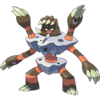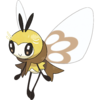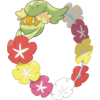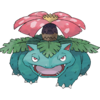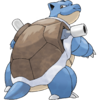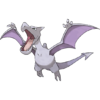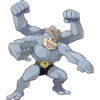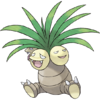At the Battle Tree, challengers compete to see how many Trainers they can defeat in a row. Losing one battle will reset the challenger's win streak to zero. Each time a challenger defeats a Trainer, Battle Points, or BP, will be awarded. The longer the win streak, the more BP will be received.
There are three formats a challenger can choose: Single Battle, Double Battle, or Multi Battle. The challenger needs three Pokémon for Single Battles, four for Double Battles, and for Multi Battles, two per Trainer. Lastly, challengers cannot use more than one of the same Pokémon or item. However, this does not restrict Multi Battle partners from using the same Pokémon or item across teams.
In Multi Battle with a friend, the highest streak is continued. The game with the lower streak will continue to receive the same rewards after each battle (BP, ribbons, stamps) and have its streak incremented with the number of battles won. Due to differences in eligibility requirements, Sun/Moon cannot participate in Multi Battles with Ultra Sun/Ultra Moon.
There are two courses for each format: Normal Course and Super Course. A Normal Course challenge consists of twenty battles, the last of which will be against a Battle Legend, one of the leaders of the facility. Upon successfully completing a Normal Course, the Super Course for the respective format will be unlocked, in which the challenger may rebattle the same Battle Legend on the fiftieth battle. Unlike the Normal Course, the Super Course is indefinite and ends only when the challenger loses a battle.
All NPC Trainers in the Battle Tree use Pokémon from a list of 996 Pokémon and moveset combinations. Each of their Pokémon has a fixed Nature and EV spread for effort values. IVs are equal across all stats and based on the Trainer using it. The gender and Ability are randomly selected each battle. Each Trainer will use two to four Pokémon, depending on the format selected.
- See more:
- List of Battle Tree Trainers
- List of Battle Tree Pokémon
Restrictions
In Pokémon Sun and Moon, both courses prohibit certain species Pokémon and are held under Flat Rules - any Pokémon higher than Lv. 50 will have their level lowered to 50. In Pokémon Ultra Sun and Ultra Moon, the level and special Pokémon restrictions are lifted for the Normal Courses, while the opponents' Pokémon are still fixed at Lv. 50.
Pokémon Sun and Moon
| Battle format
|
No. of Pokémon
|
Pokémon Level
|
Special Pokémon
|
Same Pokémon
|
Same items
|
| Single
|
3
|
Up to 50
|
Banned
|
Banned
|
Banned
|
| Super Single
|
| Double
|
4
|
| Super Double
|
| Multi
|
2 per Trainer
|
| Super Multi
|
Pokémon Ultra Sun and Ultra Moon
| Battle format
|
No. of Pokémon
|
Pokémon Level
|
Special Pokémon
|
Same Pokémon
|
Same items
|
| Single
|
3
|
No restrictions
|
Permitted
|
Banned
|
Banned
|
| Super Single
|
Up to 50
|
Banned
|
| Double
|
4
|
No restrictions
|
Permitted
|
| Super Double
|
Up to 50
|
Banned
|
| Multi
|
2 per Trainer
|
No restrictions
|
Permitted
|
| Super Multi
|
Up to 50
|
Banned
|
Special Pokémon
The following Pokémon species and their forms are banned from challenges that ban special Pokémon. Eggs cannot be used in any battle.
Battle Points
Like in the Battle Maison, the player receives Battle Points (BP) at the end of every victorious match. The number of Battle Points (BP) awarded after a match varies with the length of the current win streak, as shown in the table below.
| Battle Points
|
| Win streak
|
Normal
|
Super
|
| 1-10
|
1
|
2
|
| 11-19
|
2
|
3
|
20
(Battle Legend)
|
20
|
3
|
| 21-30
|
—
|
4
|
| 31-40
|
—
|
5
|
| 41-49
|
—
|
6
|
50
(Battle Legend)
|
—
|
50
|
| 51+
|
—
|
7
|
Battle Legends
On the 20th battle of normal challenges and the 50th battle of Super challenges, a Battle Legend will be challenged. Red is the Battle Legend for Single Battle challenges, using three Pokémon each time. Blue is the Battle Legend for Double Battles and uses four Pokémon. For Multi Battles, both Battle Legends will appear simultaneously, each using two Pokémon. Upon defeating the Battle Legend, the Pokémon used in that battle will be awarded a Battle Tree Great Ribbon or Battle Tree Master Ribbon for normal or Super mode, respectively.
Single Battle (on 20th consecutive battle)

|
|
Reward: 20BP
|
|
|
|
|
|
Super Single Battle (on 50th consecutive battle)

|
|
Reward: 50BP
|
|
|
|
|
|
Double Battle (on 20th consecutive battle)

|
|
Reward: 20BP
|
|
|
|
|
|
Super Double Battle (on 50th consecutive battle)

|
|
Reward: 50BP
|
|
|
|
|
|
Special Trainers
In Super Battles, special Trainers appear every ten battles. Like with the other Battle Tree Trainers, their teams are randomly selected from a group of Pokémon specifically preset for each of them.
In Sun and Moon, if Anabel would appear as a special Trainer but the player has not played far enough to reach Guzzlord's chapter in the Ultra Beast episode (in which Anabel first appears), she is replaced by an ordinary Trainer.
Multi Battle partners
In the Multi Battle and Super Multi Battle challenges, the player can choose to partner with a friend or with the AI. Unlike the Battle Maison from previous generations, there is only one default AI partner, Pokémon Breeder Rada. To increase the number of AI partners available, the player must Scout opponents after defeating them in Single or Double Battles. Scouting a Trainer costs 10 BP, and this will add the Trainer to the list of potential AI partners. Battle Legends cannot be scouted, but the other special Trainers can be.
As a Multi Battle partner, the scouted Trainer uses the two Pokémon that were at the start of their party when they were scouted, retaining the same Abilities that they had in that battle. However, these Pokémon will become male unless their species cannot be male. If a Trainer who has already been scouted is scouted again, their new party overwrites their previously scouted party.
In Pokémon Ultra Sun and Ultra Moon only, the player can also recruit Lillie as a partner for Multi Battles by speaking to her at Professor Kukui's laboratory at Route 1 after finishing Episode RR. She uses a Fairy-based support set.




















